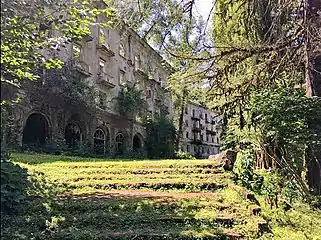Tkvarcheli
Tkvarcheli (Georgian: ტყვარჩელი [tʼqʼvɑrtʃʰɛli] (![]() listen); Abkhazian: Тҟəарчал, Tqwarchal; Ткуарчал (Tkuarchal) Russian: Ткварчели, Tkvarcheli) is a town in Abkhazia.[note 1] It is situated on the river Ghalidzga (Aaldzga) and a railroad connects it with Ochamchire. Akarmara, an area within the town, is a ghost town with abandoned apartments and factories which became uninhabited in the early 1990s due to the War in Abkhazia (1992-3).[1]
listen); Abkhazian: Тҟəарчал, Tqwarchal; Ткуарчал (Tkuarchal) Russian: Ткварчели, Tkvarcheli) is a town in Abkhazia.[note 1] It is situated on the river Ghalidzga (Aaldzga) and a railroad connects it with Ochamchire. Akarmara, an area within the town, is a ghost town with abandoned apartments and factories which became uninhabited in the early 1990s due to the War in Abkhazia (1992-3).[1]
Tkvarcheli
ტყვარჩელი, Тҟəарчал, Ткварчели Tqvarcheli, Tqwarchal, Tkvarcheli | |
|---|---|
Town | |
 Aerial view of the town | |
 location of Tkvarcheli within Abkhazia | |
| Country | Georgia |
| de facto state | Abkhazia[note 1] |
| District | Tkvarcheli |
| Population (2011) | |
| • Total | 5,013 |
| Time zone | UTC+03:00 (MSK) |
History
Coal mining, which began in the area in 1935, grew in importance during the Second World War, especially after the Donbass was lost during the German invasion of the Soviet Union. Tkvarcheli was given town status on 9 April 1942 [2]
During the War in Abkhazia (1992-3), Tkvarcheli withstood, through Russian military aid, an uneasy siege by the Georgian forces. Since 1995, it is the centre of the newly formed Tkvarcheli District. On 27 September 2008, President Sergei Bagapsh awarded it the honorary title of Hero City.[2]
Industry
Coal-mining has been the town's main industry, although now the Soviet mines are closed and coal is quarried only by the Abkhaz-Turkish Tamsaş company using the open pit method.[1] Tamsaş's tax payments account for 75% of the Tkvarcheli district's budget however, the company was criticised for neglecting environmental requirements.[3] Construction of a new cement plant is planned now, its output to be used for the Olympic construction projects in Sochi.[4] Georgia regards all this investment as illegal, in clear violation of the 1996 CIS restrictions[5] and has arrested several vessels, loaded with coal from Tkvarcheli, in its territorial waters, a measure that has reportedly brought Tamsaş to the verge of bankruptcy.[6]
Demography
The town's population was 21,744 in 1989. The three main ethnic groups were Abkhaz (42.3%), Russians (24.5%) and Georgians (23.4%).[7] As a result of the War in Abkhazia the town's industries all but stopped and its population decreased greatly and was between 7,000 and 8,000 in 2004 according to some sources[8] and only 4,800 according to others.[9] At the time of the 2003 census, its population was 4,786. By the time of the 2011 census, it had increased to 5,013. Of these, 66.5% were Abkhaz, 17.4% Georgian, 9.7% Russian, 1.3% Ukrainian, 1.1% Armenian, 0.4% Greek and 0.1% Svan.[10]
Gallery
 View of the Akarmara ghost town near Tkvarcheli
View of the Akarmara ghost town near Tkvarcheli View of an abandoned factory in Akarmara
View of an abandoned factory in Akarmara View of abandoned apartments in Akarmara
View of abandoned apartments in Akarmara
Notes
- Abkhazia is the subject of a territorial dispute between the Republic of Abkhazia and Georgia. The Republic of Abkhazia unilaterally declared independence on 23 July 1992, but Georgia continues to claim it as part of its own sovereign territory and designates it as a territory occupied by Russia. Abkhazia has received formal recognition as an independent state from 7 out of 193 United Nations member states, 1 of which has subsequently withdrawn its recognition.
References
- Inal Khashig Tkuarchal, Abkhazia – a former coal capital trying to survive 05.09.2020 JAMnews
- "Городу-Герою Ткуарчал исполняется 70 лет". Apsnypress. 9 April 2012. Retrieved 11 April 2012.
- The Turkish Tamsas Can Resume Mining in Abkhazia If It Complies with Environmental Requirements Archived 2007-09-28 at the Wayback Machine 09/11/2006 18:00, Official site of the President of Abkhazia
- Ткуарчал отметил 65-летний юбилей 20/04/2007 18:13, Official site of the President of Abkhazia Archived 2007-09-28 at the Wayback Machine
- Abkhazia Today. The International Crisis Group Europe Report N°176, 15 September 2006. Retrieved on September 30, 2007. Free registration needed to view full report
- Abkhaz MP: Georgia’s Sea Seizure Pose Threat to Abkhaz Coal Industry. Civil Georgia. October 26, 2007.
- Abkhazia census statistics(in Russian)
- Отчет миссии ПРООН по изучению возможностей Гальского района и смежных с ним территорий Абхазии, Грузия, Апрель 2004 Archived 2007-09-25 at the Wayback Machine
- Абхазия - город Ткварчели
- 2011 Census results
| Wikimedia Commons has media related to Tkvarcheli. |

